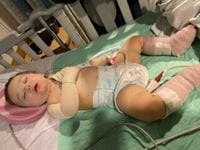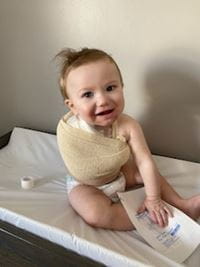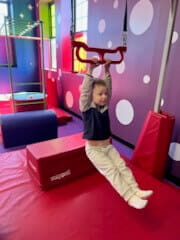After a long labor and complex delivery, Pittsburgh resident Sara and her husband, Dan, welcomed their first child, Hayden, on January 26, 2020, at UPMC Magee-Womens Hospital in Pittsburgh.
Measuring 22.5 inches, Hayden was “a tall baby,” as Sara puts it.
“When I was in the delivery, the doctors told us that Hayden was bigger than we initially thought. He ended up being 9 pounds when we had anticipated he was about 7 pounds during my pregnancy. But because of that they told us that there may be complications getting him out.”
 Doctors advised Sara that if he became stuck in the birth canal, there was a risk he may acquire what is called a brachial plexus birth palsy.
Doctors advised Sara that if he became stuck in the birth canal, there was a risk he may acquire what is called a brachial plexus birth palsy.
A brachial plexus birth palsy — also referred to as Erb’s palsy when it affects the upper trunk of the brachial plexus nerves — is a condition when the brachial plexus nerves that come from the neck and travel down the arm and into the hand become stretched, compressed, or even torn during birth.
The condition is relatively common, occurring in about one to three out of every 1,000 births. The result might be decreased muscle function, or even total paralysis of the upper extremity, depending on which nerves are affected.
Most infants with brachial plexus birth palsy will recover a significant amount of movement and feeling in the affected arm with supportive care, physical therapy exercises, or surgery. Recovery is variable, so it is important that patients with a brachial plexus palsy are evaluated in a timely manner.
Shortly after Hayden came into the world, doctors evaluated his arm to see the range of movement he had and observe him for a brachial plexus palsy. At birth, they were fairly certain that he did have a palsy, but they would need to wait for him to grow a bit to do a full evaluation and to give a diagnosis. The family’s pediatrician Laura Voigt, MD, at UPMC Children’s Community Pediatrics – Bass Wolfson, Squirrel Hill, referred them to UPMC Children’s Hospital of Pittsburgh’s Brachial Plexus Clinic for that evaluation when Hayden was 2 or 3 months old.
“I always had a really good perception of Children’s,” said Sara. “I’m a type 1 diabetic, and as a child myself I had a lot of care at Children’s and have always had a good experience. And as parent, you know that if you have kids you go to a children’s hospital for care, so that’s what we did.”
 Hayden and family met with a physician and staff in the Clinic who conducted the evaluation – moving Hayden’s arm and determining what kind of movement he had in the arm and hand.
Hayden and family met with a physician and staff in the Clinic who conducted the evaluation – moving Hayden’s arm and determining what kind of movement he had in the arm and hand.
“They held up things that he wanted and would see if he reached for them,” said Sara.
It was observed that while Hayden had good movement in his hands, he was unable to move his arm up above his shoulder or flex his elbow. Both of those observations were consistent with a brachial plexus palsy of the upper trunk.
Daily physical therapy is the main initial treatment method for a brachial plexus birth palsy. The amount of movement and feeling that can be regained through physical therapy alone varies by patient and the extent of the individual’s injury. Typically, patients are seen routinely over several months to determine if they have recovered enough function to effectively participate in activities of daily living. If not, surgical intervention may be advised to help the child regain a fuller range of motion.
Because these children are often diagnosed as babies, parents play a key role the recovery process. Once he was diagnosed in March 2020, Hayden’s doctors advised them to begin physical therapy. The Brachial Plexus Clinic staff would continue to monitor Hayden’s progress over the months to come to determine if surgery would be necessary for him.
Hayden and Sara began daily physical therapy. About once a month they would come to Children’s and meet with physical therapists and occupational therapists to learn exercises. Then Sara would take those exercises home and work with Hayden.
“At the start, I could work with Hayden on a lot of the exercises while he was laying in my lap. There was a lot of stretching and general movement of him arms,” said Sara.
They continued the physical therapy for about seven months, checking in with the Brachial Plexus Clinic staff about every 3 months to monitor progress.
 In October 2020, when Hayden was about 10 months old, he had made a good amount of progress with physical therapy, but he had not regained a full range of motion. At this point, Sara met with Alexander Davit, MD, director of the Pediatric Brachial Plexus Clinic within the Division of Pediatric Plastic Surgery at Children’s. Together they decided that surgery would be the best choice for Hayden and helping to improve his upper extremity function and feeling.
In October 2020, when Hayden was about 10 months old, he had made a good amount of progress with physical therapy, but he had not regained a full range of motion. At this point, Sara met with Alexander Davit, MD, director of the Pediatric Brachial Plexus Clinic within the Division of Pediatric Plastic Surgery at Children’s. Together they decided that surgery would be the best choice for Hayden and helping to improve his upper extremity function and feeling.
“With the physical therapy, his arm did start moving a bit, but only to a point. He couldn’t move it up over his head,” said Sara. “And with the surgery, the goal is more significant function. Making sure he can do things for himself in the future, like wash his own hair. We wanted Hayden to not be limited by the injury in his future, so we decided that surgery was the best option.”
Two days before Christmas 2020, Hayden underwent brachial plexus reconstructive surgery at Children’s Lawrenceville location. During the six-hour surgery, Dr. Davit, along with Stephanie Greene, MD, director of vascular neurosurgery and perinatal neurosurgery at Children’s, completed reconstruction of Hayden’s brachial plexus using nerve grafts taken from the back of Hayden’s legs. They used the grafts to reconstruct the nerve defect after removal of the stretched and thickly scarred upper trunk brachial plexus nerve.
Hayden stayed overnight for observation and was released the next day.
After surgery, Hayden was “wrapped up like a little mummy” in a sling that he had to wear for several weeks. Hayden and his parents returned every three months for a year for checkups. They also continued physical therapy after his surgery for about a year and half.
 Today, Hayden has made a wonderful recovery and has near complete function of his arm. He is an active 3-year-old who loves balloons, climbing, swinging, and anything outside, and is not limited by any functional issues.
Today, Hayden has made a wonderful recovery and has near complete function of his arm. He is an active 3-year-old who loves balloons, climbing, swinging, and anything outside, and is not limited by any functional issues.
“The hardest part of going through with the surgery was that the movement he had [in his arm] prior to surgery went completely away right after the surgery. But then it came back and even better,” says Sara. “It was incredible. I honestly didn’t expect him to do as well as he did.”
Though Hayden did require surgical intervention, Sara wanted to emphasize for other parents the importance of physical therapy in her son’s recovery.
“I can’t say enough good things about the physical therapy component,” said Sara. “My advice to other parents in a similar situation is to do the physical therapy. Always. Even if it’s inconvenient. Hayden is super strong now and he wouldn’t have had that without the physical therapy component.”
 Sara was also impressed by the collaboration between Dr. Davit and Dr. Greene who ensured that Hayden would receive the most optimal care possible by engaging experts from multiple surgical specialties.
Sara was also impressed by the collaboration between Dr. Davit and Dr. Greene who ensured that Hayden would receive the most optimal care possible by engaging experts from multiple surgical specialties.
“We’re lucky to have access to an academic medical center in our region where providers are always learning better techniques and treatments,” said Sara.
Nowadays, Sara says you would have no idea Hayden had a brachial plexus birth palsy or the surgery to repair it.
“It was a tough decision to make with a small child,” she says, “But in the end, it’s the best decision we could’ve made. It’s worth it.”
To schedule an appointment with the Brachial Plexus Clinic at UPMC Children’s Hospital of Pittsburgh, please call 412-692-8650 and press the appropriate option.
Hayden's treatment and results may not be representative of all similar cases.
Hayden's mother, Sara DiFiore, is a researcher at the University of Pittsburgh who collaborates with UPMC colleagues.









